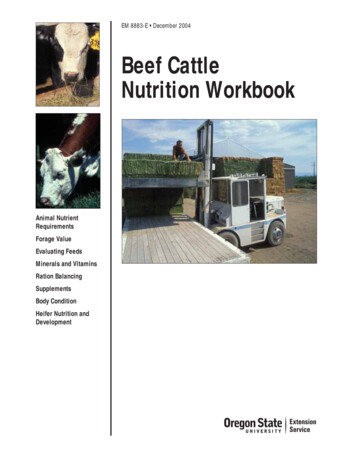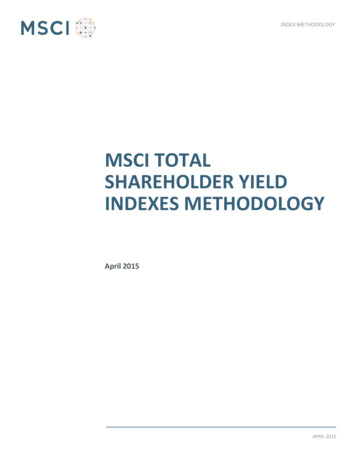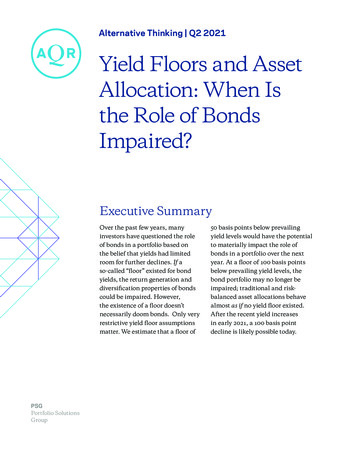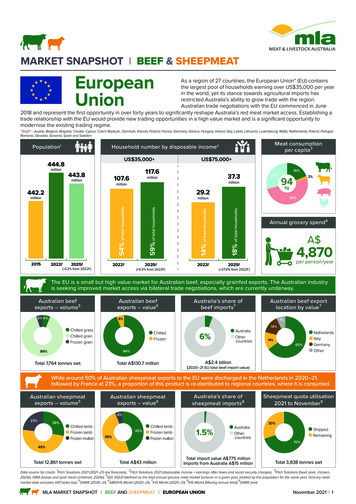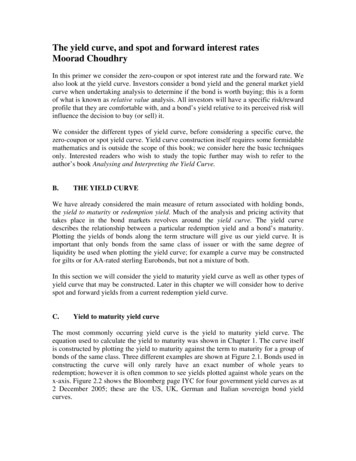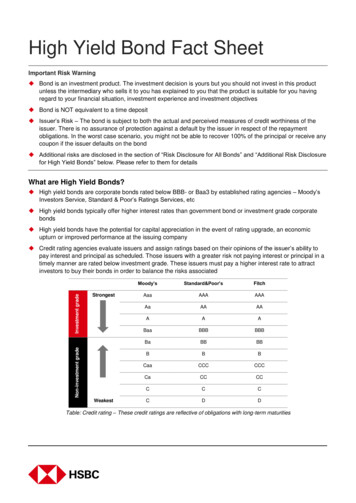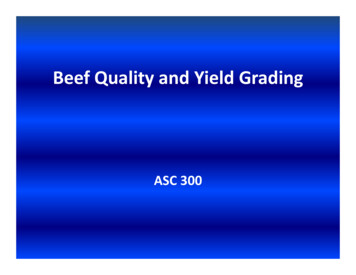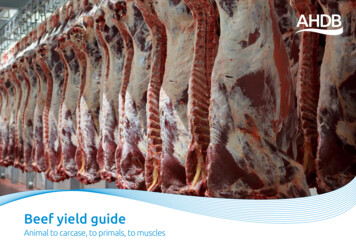
Transcription
Beef yield guideAnimal to carcase, to primals, to muscles1
Contents2 Processing the beef carcase,from farm to plate4 Beef primal cuts6 Beef carcase classification7 Beef carcase to primal cuts –yield information11 Primals into individual muscles12 Shoulder muscles14 Chuck roll muscles and cuts15 Fore rib muscles and cuts16 Brisket muscles17 Topside muscles19 Silverside cuts20 Thick flank muscles21 Rump muscles22 Fillet muscles and cuts23 Sirloin muscles and cuts24 Thin flank muscles25 Heel muscle and hindshin musclesProcessing the beef carcase,from farm to plateWaste/offal/by-products 47%The industry aim is to add value, useevery part of the carcase and minimisewastage. This brochure has beenproduced to help people working withbeef to get a basic understanding aboutthe yield figures from farm to plate.Traditionally, the carcase is divided intohindquarter and forequarter primal cuts.Each of these primal cuts is then cutinto a range of individual cuts andmuscles, from which weights have beentaken, to calculate the overall yield.1. KKCF or can go as an edible co-product to be rendered for humanconsumption, e.g. baking and frying, petfood, soap manufacture,pharmaceuticals or biofuel.2. These products require further processing before they are fit for humanconsumption.3. See Regulation (EC) No 1069/2009 and gov.uk/dealing-with-animal-by-products.2kg% ofcarcase weight% ofliveweightHide42.4915.077.08Fat can be used directly with the meat1Lung fat1.570.560.26Caul fat14.545.162.42KKCF11.183.961.86Cod fat4.491.590.75There is normally a home market for all these 120.400.19Heart2.230.790.37Liver7.852.781.31Tongue incl trimmings2.240.790.37Head & cheek meat incl.2.120.750.35trimmingsLips1.120.400.19Edible co products2Stomachs15.655.552.61Feet11.183.961.86Fit for human consumptionLungs3.581.270.60Trachea (weasand) & trim1.110.390.19Pizzle & eads (thymus)0.340.120.06Other3Spleen & pancreas1.270.450.21Gall 50.26Remainder7.272.581.21Blood20.137.143.36Gut & intestinal contents86.0030.5014.33Remainder head: skull,6.912.451.15tonsils, brain, eyesSpinal cord0.180.060.03Intestinal fat13.424.762.24Intestines incl. ctionDick van LeeuwenAHDB Business Development Managerand Master ButcherProductAnimal 100%Figures from a from a 600kg steerof average fatness R4L
Carcase 53%Bone/fat/drip loss 13%Edible meat 40%3
Forequarter primal cutsNeck of Beef (boneless)Chuck Roll1Rib EyeDenver Muscle2Blade (Chuck Tender)Underblade Muscle3Underblade Fillet4Fore Rib (bone-in)56Feather27LMC (single muscle)8Baby LMC91Clod Flat MuscleClod Shin Muscle11Shoulder Brisket Muscle12Fore Shin134514912191011171613NeedleFlat Brisket1641415171815Brisket Cap Muscle1820681073Forequarter Flank (bone-in)19
Hindquarter primal cutsStriploinFilletRump Cap (Picanha)202127222422Silverside(without Salmon Cut)28Salmon Cut(Silverside Round)2936382325233433Rump Bistro Muscle24Topside262521Prime Rump3226Tender Top Muscle(adductor)3027Heel Muscle31373528Hind ShinPrime Hind Shin Muscle30Rump TailThin Flank (boneless)34Flank Skirt (Bavette)35Centre Cut Muscle –Thick FlankThick Flank (Knuckle)3132Goose Skirt362933Inside Skirt37385
Beef carcase classificationCarcase assessment addresses conformation and fat. Fat cover is scored on a 1-5 scale. Conformation isassessed from E to P. Combining scores for conformation and fat determines the markets which cattle suit.FAT CLASSCarcases within the following parameterscan carry the Quality Standard Mark. Increasing fatnessFat is determined by visual assessment of external fat cover. There are five main classes.Classes 4 and 5 are subdivided into L (leaner) and H (fatter)1234L4H5L 5H 6 EConformation is determined by a visual appraisal of shape, takinginto account carcase profile and fullness of legs. No adjustmentis made for the influence of fat on overall shape.CONFORMATION CLASSImproving conformation U -URO -OP -PThe Quality Standard Mark Schemestipulates specific carcase classificationsfor beef. Fat Class 2-4H, ConformationE-O , the optimum classification forbetter meat yield (see note on right). emales under the age of 36 months areFacceptable. They must not have beenused for breeding or be in calf, they mustnot be pregnantSteers under the age of 36 monthsare acceptableCarcases must have a fat class ofbetween 2–4H and have a conformationof E–O For qualifying livestock 30 months orunder: Maturation of 7 days is requiredon primals used for frying, roastingand grilling (from slaughter to thefinal consumer) or qualifying livestock aged betweenF30–36 months: Maturation of 14 daysis required on primals used for frying,roasting and grilling (from slaughter tothe final consumer). Alternatively, one ofthe post-slaughter processes to enhancetenderness as outlined in ‘AHDB Beef &Lamb Guidance to Meat Quality’ can beused, ie, Hip bone suspension orelectrical stimulationBulls must be no older than 16 monthsat slaughter. Primals used for frying,roasting and grilling must be subjectto a minimum 14 days maturation(from slaughter to the final consumer)
Beef carcase to primal cuts – yield informationNeck of Beef (boneless)Chuck RollFore Rib bone-inFlat BrisketCode: Chuck B033Code: Chuck B002Code: Forerib B001Code: Brisket B001Description: The neck is removed bya straight cut parallel to the first rib andthrough the junction of the 7th cervical and1st thoracic vertebrae.Description: The chuck roll is a versatile muscleand can be used for a slow cooked roast,steaks or dice.Description: The fore rib contains ribs 7, 8, 9and 10 counting from the neck upwards.Maximum 60 mm tail. Maximum fat thickness10 mm.Description: Flat Brisket is bonelessand highly trimmed, maximum fatthickness 10 mm.Weight Weight Weight Weight Percentage of carcase 3.92 kg2.59%7.19 kgPercentage of carcase 4.75%Percentage of carcase 8.23 kg5.43%Percentage of carcase 5.34 kg3.52%Blade (Chuck Tender)FeatherLMC (single muscle)Baby LMCCode: Chuck B008Code: Chuck B010Code: LMC B001Code: FQ B004Description: The blade is a forequarter muscleand is ideal for slow cooking.Description: The feather is a distinctive musclewith lots of flavour. It contains a thick gristle runningthrough the middle of the joint and, when cookedslowly, the gristle will turn into jelly.Description: A cut from the shoulder with veryversatile usage.Description: This cut is from the shoulder andis situated next to the LMC.Weight WeightWeight Weight (Supraspinatus)Percentage of carcase (Infraspinatus)1.50 kg0.99% Percentage of carcase(Triceps brachaii caput longum) 2.46 kg1.62%Percentage of carcase (Triceps brachaii caput laterale)3.31 kg2.18%Percentage of carcase 0.71 kg0.47%The information in this brochure is based on a 303kg carcase (side weight 151.5kg), Classification R4H (after 2 weeks maturation).Therefore, the weights/percentages of cuts are intended to act as a guide only, as butchery techniques, carcase weights and types may vary from one business to another.7
Beef carcase to primal cuts – yield informationUnderblade MuscleUnderblade FilletFore ShinNeedleCode: Chuck B021Code: Chuck B022Code: Shin B003Code: Shin B008Description: When trimmed of all connectivetissue, this muscle is very tender and ideal forstir-fry, steaks or pavés.Description: When trimmed of all connectivetissue, this muscle is very tender and ideal forstir-fry, steaks or pavés.Description: Trimmed of excess fat.This muscle is ideal for slow cooking.Description: The needle is a single musclesituated next to the fore shin muscle andis ideal for braising steaks, slow or sousvide cooking.Weight Weight Weight (Subscapularis)Percentage of carcase (Teres minor)1.09 kg0.72%Percentage of carcase 0.43 kg0.28%Percentage of carcase 2.05 kg1.35%Clod Shin MuscleClod Flat MuscleShoulder Brisket MuscleCode: Shin B011Code: FQ B006Code: FQ B008Description: The clod shin is a single musclefrom the shoulder with a similar grain to shin,hence the name. It is ideal for slow or sousvide cooking.Description: This cut is from the shoulder andis situated next to the Baby LMC.Description: This muscle is the extension ofthe rib cap muscle and is attached to the LMC.The grain of the muscle is similar to the brisket,hence the name.Weight Weight Weight (Biceps brachaii)Percentage of carcase (Brachialis)0.60 kg0.40%Percentage of carcase (Latissimus dorsi)0.45 kg0.30%Percentage of carcase The information in this brochure is based on a 303kg carcase (side weight 151.5kg), Classification R4H (after 2 weeks maturation).Therefore, the weights/percentages of cuts are intended to act as a guide only, as butchery techniques, carcase weights and types may vary from one business to another.8(Extensor carpi radialis)0.72 kg0.48%Weight Percentage of carcase 0.64 kg0.42%
Beef carcase to primal cuts – yield informationTopsideSilverside (without silver gristle)Thick Flank (Knuckle)‘D’ Rump (without tail)Code: Topside B001Code: Silverside B001Code: Thick Flank B001Code: Rump B004Description: Whole topside. Exposed bloodveins are removed and maximum fat thicknessis 10 mm.Description: Whole silverside and salmon cut.Internal fat pockets and silver gristle areremoved. Maximum fat level 15 mm.Description: Rump tail and fat pockets areremoved, maximum fat level 10 mm.Description: This rump contains no rump tail.Maximum fat thickness is 10 mm.Weight Weight Weight Weight Percentage of carcase 9.89 kg6.53%Percentage of carcase 9.66 kg6.38%Percentage of carcase 6.40 kg4.22%Percentage of carcase Rump TailStriploinFilletThin Flank (boneless)Code: Rump B012Code: Sirloin B002Code: Fillet B001Code: Thin Flank B009Description: Maximum fat thickness 10 mm.Description: A 3-rib boneless sirloin with theflank removed 40 mm from the tip of the eyemuscle. 25 mm backstrap is removed and fatlevel is not to exceed 10 mm.Description: Whole fillet with chain. External fatand discoloured tissue removed.Description: 3- bone thin flank primal(boneless).Weight Weight Weight Weight (Tensor fasciae latae)Percentage of carcase 1.42 kg0.94%Percentage of carcase (Psoas major and psoas minor)6.80 kg4.49%Percentage of carcase 2.91 kg1.92%Percentage of carcase 5.99 kg3.95%10.09 kg6.66%The information in this brochure is based on a 303kg carcase (side weight 151.5kg), Classification R4H (after 2 weeks maturation).Therefore, the weights/percentages of cuts are intended to act as a guide only, as butchery techniques, carcase weights and types may vary from one business to another.9
Beef carcase to primal cuts – yield informationHeel MuscleTrim/Muscles 85% VLCode: Leg B001Code: Trim B019(Gastrocnemius)Primal cuts as a percentage of the carcaseCutNeckChuck RollDescription: Example of 85% visual leanmuscle/trimmings.Weight Weight Percentage of carcase 2.63 kg1.74%Hind ShinPercentage of carcase 17.29 kg11.41%4.755.43Blade (Chuck Tender)Chuck B0080.99FeatherChuck B0101.62LMC (single muscle)LMC B0012.18Underblade MuscleChuck B0210.72Underblade FilletChuck B0220.28Flat BrisketWeight Percentage of carcase Weight Percentage of carcase Description: Trimmed of excess fat.This muscle is ideal for slow cooking.Percentage of carcase 3.52Shin B0031.35Clod Shin MuscleShin B0110.40Clod Flat MuscleFQ B0060.30Baby LMCFQ B0040.47Shoulder BrisketTopside8.75 kg5.78%BoneWeight Brisket B001Fore Shin16.17%Drip Loss2.58 kg1.70%Weight Percentage of carcase 3.96 kg2.61%0.426.536.38Thick Flank B0014.22“D” Rump (without tail)Rump B0043.95Rump TailRump B0120.94StriploinSirloin B0024.49Fillet B0011.92Thick FlankThin Flank (boneless)Thin Flank B0096.66Heel MuscleLeg B0011.74Hind ShinShin B0021.70Trim 85% VLTrim B01911.41Fat–5.78Bone–16.17Drip/cutting loss(2 weeks maturation)–2.61TotalThe information in this brochure is based on a 303kg carcase (side weight 151.5kg), Classification R4H (after 2 weeks maturation).Therefore, the weights/percentages of cuts are intended to act as a guide only, as butchery techniques, carcase weights and types may vary from one business to another.100.48Topside B001Fillet24.49 kgFQ B008Shin B008Silverside B001SilversideCode: Shin B0022.59Chuck B002NeedleFat% of carcaseFore Rib B001Fore Rib bone-inDescription: The heel muscle is trimmed ofexcess fat. This muscle is ideal for slow cookingand is similar to shin meat.CodeChuck B033100
Primals into individual musclesThis section shows the individual muscles and cutsas a percentage of the primal and of the carcase.This example shows how the topside primal isbroken down into the main muscles.Main Topside Muscle(Semimembranosus)Code: Topside B018Tender Top Muscle(Adductor)Code: Topside B019Topside fully trimmed(without gracilis)Code: Topside B017TopsideCode: Topside B001Small Side Bullet Muscle(Pectineus)Code: Topside B022Gracilis Muscle – TopsideCode: Topside B021Topside Flap Muscle(Sartorius)Code: Topside B023The information in this brochure is based on a 303kg carcase(side weight 151.5kg), Classification R4H (after 2 weeks maturation).Therefore, the weights/percentages of cuts are intended to act as aguide only, as butchery techniques, carcase weights and types mayvary from one business to another.11
Shoulder musclesShoulder (bone-in)Shoulder (boneless)Blade (Chuck Tender)FeatherCode: FQ B001Code: FQ B002Code: Chuck B008Code: Chuck B010Description: Bone-in shoulder of beef.Description: Boneless shoulder of beef.Description: The blade is a forequarter muscleand is ideal for slow cooking.Description: The feather is a distinctive musclewith lots of flavour. It contains a thick gristle runningthrough the middle of the joint and, when cookedslowly, the gristle will turn into jelly.Weight Weight Weight Percentage of carcase 22.10 kg14.59%Weight Percentage of bone-in primal Percentage of carcase (Supraspinatus)17.06 kg77.19%11.26%Percentage of bone-in primal Percentage of carcase (Infraspinatus)1.51 kg6.79%0.99%Percentage of bone-in primal Percentage of carcase 2.46 kg11.13%1.62%LMC (single muscle)Baby LMCUnderblade MuscleUnderblade FilletCode: LMC B001Code: FQ B004Code: Chuck B021Code: Chuck B022Description: A cut from the shoulder with veryversatile usage.Description: This cut is from the shoulder andis situated next to the LMC.Description: When trimmed of all connectivetissue, this muscle is very tender and ideal forstir-fry, steaks or pavés.Description: When trimmed of all connectivetissue, this muscle is very tender and ideal forstir-fry, steaks or pavés.Weight Weight Weight Weight (Triceps brachaii caput longum)Percentage of bone-in primal Percentage of carcase (Triceps brachaii caput laterale)3.31 kg14.98%2.18%Percentage of bone-in primal Percentage of carcase (Subscapularis)0.71 kg3.21%0.47%Percentage of bone-in primal Percentage of carcase The information in this brochure is based on a 303kg carcase (side weight 151.5kg), Classification R4H (after 2 weeks maturation).Therefore, the weights/percentages of cuts are intended to act as a guide only, as butchery techniques, carcase weights and types may vary from one business to another.12(Teres minor)1.09 kg4.93%0.72%Percentage of bone-in primal Percentage of carcase 0.43 kg1.95%0.28%
Shoulder musclesFore ShinNeedleClod Shin MuscleCode: Shin B003Code: Shin B008Code: Shin B011Description: Trimmed of excess fat.This muscle is ideal for slow cooking.Description: The needle is a single musclesituated next to the fore shin muscle and is idealfor braising steaks, slow or sous vide cooking.Description: The clod shin is a single musclefrom the shoulder with a similar grain to shin,hence the name. It is ideal for slow or sousvide cooking.Weight Weight Weight Percentage of bone-in primal Percentage of carcase (Extensor carpi radialis)2.05 kg9.28%1.35%Percentage of bone-in primal Percentage of carcase (Biceps brachaii)0.64 kg2.90%0.42%Clod Flat MuscleShoulder Brisket MuscleCode: FQ B006Code: FQ B008Description: This cut is from the shoulder andis situated next to the Baby LMC.Description: This muscle is the extension ofthe rib cap muscle and is attached to the LMC.The grain of the muscle is similar to the brisket(hence the name).Weight Weight (Brachialis)Percentage of bone-in primal Percentage of carcase Percentage of bone-in primal Percentage of carcase 0.60 kg2.71%0.40%(Latissimus dorsi)0.45 kg2.04%0.30%Percentage of bone-in primal Percentage of carcase 0.72 kg3.26%0.48%The information in this brochure is based on a 303kg carcase (side weight 151.5kg), Classification R4H (after 2 weeks maturation).Therefore, the weights/percentages of cuts are intended to act as a guide only, as butchery techniques, carcase weights and types may vary from one business to another.13
Chuck roll muscles and cutsChuck RollDenver MuscleChuck Eye ‘Centre Cut’ JointRib Eye FilletCode: Chuck B002Code: Chuck B034Code: Chuck B026Code: Chuck B027Description: The chuck roll is a versatile muscleand can be used for a slow cooked roast,steaks or dice.Description: The Denver muscle (serratusventralis), also called the spider muscle,with discoloured tissue, gristle and excessfat removed.Description: This joint has a smaller diameterthan the Chuck Eye Joint and is ideal for aslow roast.Description: The rib eye fillet is the continuationof the rib eye situated in the chuck.Weight 2.36kgWeight Weight 1.56%Percentage of carcase Weight Percentage of carcase (Serratus ventralis)7.19 kg4.75%Percentage of primal Percentage of carcase 32.82%Percentage of primal The information in this brochure is based on a 303kg carcase (side weight 151.5kg), Classification R4H (after 2 weeks maturation).Therefore, the weights/percentages of cuts are intended to act as a guide only, as butchery techniques, carcase weights and types may vary from one business to another.142.76 kg38.38%1.82%(Longissimus dorsi)Percentage of primal Percentage of carcase 0.38 kg5.29%0.25%
Fore rib muscles and cutsFore Rib (bone-in)Fore Rib – Carvery (rolled)Rib Eye RollBeef Mini Back Ribs –2-bone RackCode: Fore Rib B001Code: Fore Rib B005Code: Fore Rib B009Code: Fore Rib B016Description: The fore rib contains ribs 7, 8, 9 and10 counting from the neck upwards. Maximum60 mm tail. Maximum fat thickness 10 mm.Description: Back, chine bones and backstrapare removed. Maximum 75 mm tail and fatthickness 10 mm.Description: The eye muscle is removed fromthe fore rib (Code: Fore Rib B001) and can beused as a joint or cut into rib eye steaks.Maximum fat thickness 10 mm.Description: These racks are produced fromthe fore rib section.Weight Weight Weight Weight Percentage of carcase 8.23 kg5.43%Percentage of primal Percentage of carcase 7.17 kg87.12%4.73%Percentage of primal Percentage of carcase 2.82 kg34.26%1.86%Percentage of primal Percentage of carcase 1.25 kg15.19%0.83%The information in this brochure is based on a 303kg carcase (side weight 151.5kg), Classification R4H (after 2 weeks maturation).Therefore, the weights/percentages of cuts are intended to act as a guide only, as butchery techniques, carcase weights and types may vary from one business to another.15
Brisket musclesFlat BrisketBrisket PATBrisket Cap MuscleCode: Brisket B001Code: Brisket B012Code: Brisket B013Description: Flat brisket is boneless and highlytrimmed, maximum fat thickness 10 mm.Description: This is the single brisket musclewith the cap removed. Trimmed of all excess fatand gristle.Description: The cap muscle is a single muscleremoved from the brisket and trimmed of allexcess fat and gristle. The meat has a coarsetexture/grain and needs slow, long cooking.Weight Weight Weight Percentage of carcase (Pectoralis profundus)5.34 kg3.52%Percentage of primal Percentage of carcase (Pectoralis superficialis)2.80 kg52.43%1.84%Percentage of primal Percentage of carcase The information in this brochure is based on a 303kg carcase (side weight 151.5kg), Classification R4H (after 2 weeks maturation).Therefore, the weights/percentages of cuts are intended to act as a guide only, as butchery techniques, carcase weights and types may vary from one business to another.161.30 kg24.34%0.86%
Topside musclesTopsideTopside (without gracilis)Topside fully trimmed(without gracilis)Code: Topside B001Code: Topside B016Code: Topside B017Description: Boneless trimmed topsidewithout gracilis.Description: This topside contains only themain topside muscle (semimembranosus) andthe tender top muscle (adductor) and is fullytrimmed.Description: Whole topside. Exposed bloodveins are removed and maximum fat thicknessis 10 mm.Weight Percentage of carcase 9.89 kg6.53%Weight Percentage of primal Percentage of carcase 7.21 kg72.90%4.76%Main Topside MuscleTender Top MuscleCode: Topside B018Code: Topside B019Description: The main topside muscle(semimembranosus) is fully trimmed.Description: The tender top muscle (adductor)is fully trimmed.(Semimembranosus)Weight Percentage of primal Percentage of carcase Weight Percentage of primal Percentage of carcase 6.70 kg67.70%4.42%(Adductor)5.14 kg52.00%3.39%Weight Percentage of primal Percentage of carcase 1.55 kg15.67%1.02%The information in this brochure is based on a 303kg carcase (side weight 151.5kg), Classification R4H (after 2 weeks maturation).Therefore, the weights/percentages of cuts are intended to act as a guide only, as butchery techniques, carcase weights and types may vary from one business to another.17
Topside musclesGracilis and associatedmuscles – TopsideGracilis Muscle – TopsideSmall Side Bullet MuscleTopside Flap MuscleCode: Topside B020Code: Topside B021Code: Topside B022Code: Topside B023Description: This group of muscles containsthe gracilis, pectineus and sartorius.Description: This muscle is positioned on topof the topside.Description: This muscle is positioned next tothe tender top muscle (adductor) and isextremely tender.Description: This muscle is positioned betweenthe topside muscles and the thick flank.Weight Weight Weight Weight Percentage of primal Percentage of carcase 2.37 kg23.96%1.56%Percentage of primal Percentage of carcase (Pectineus)1.33 kg13.45%0.88%Percentage of primal Percentage of carcase The information in this brochure is based on a 303kg carcase (side weight 151.5kg), Classification R4H (after 2 weeks maturation).Therefore, the weights/percentages of cuts are intended to act as a guide only, as butchery techniques, carcase weights and types may vary from one business to another.18(Sartorius)0.55 kg5.56%0.36%Percentage of primal Percentage of carcase 0.25 kg2.53%0.17%
Silverside cutsSilverside (with silver gristle)Silverside (without silver gristle)Silverside (without Salmon Cut)Salmon Cut (Silverside Round)Code: Silverside B009Code: Silverside B001Code: Silverside B011Code: Silverside B010Description: Whole silverside and salmon cut.Internal fat pockets are removed but silver gristleremains. Maximum fat level 15 mm.Description: Whole silverside and salmon cut.Internal fat pockets and silver gristle areremoved. Maximum fat level 15 mm.Description: Whole silverside without the salmoncut. Internal fat pockets and silver gristle areremoved. Maximum fat level 15 mm.Description: Maximum fat level 15 mm.Weight Weight Weight (Gluteobiceps and semi tendinosus)Weight Percentage of carcase 9.66 kg6.38%(Gluteobiceps and semi tendinosus)Percentage of primal Percentage of carcase 9.45 kg97.82%6.24%Percentage of primal Percentage of carcase 6.38 kg66.05%4.21%(Semi tendinosus)Percentage of primal Percentage of carcase 2.80 kg29.00%1.85%The information in this brochure is based on a 303kg carcase (side weight 151.5kg), Classification R4H (after 2 weeks maturation).Therefore, the weights/percentages of cuts are intended to act as a guide only, as butchery techniques, carcase weights and types may vary from one business to another.19
Thick flank musclesThick Flank (Knuckle)Pavé Muscle – Thick FlankFemur Muscle – Thick FlankCode: Thick Flank B001Code: Thick Flank B008Code: Thick Flank B009Description: Rump tail and fat pockets areremoved, maximum fat level 10 mm.Description: The pavé muscle from the thickflank is positioned next to the topside and isextremely tender.Description: The femur muscle from the thickflank is positioned next to the femur bone.Weight Weight Weight Percentage of carcase (Vastus medialis)6.40 kg4.22%Percentage of primal Percentage of carcase (Vastus intermedius)0.68 kg10.62%0.45%Centre Cut Muscle – Thick FlankPlate Muscle – Thick FlankCode: Thick Flank B010Code: Thick Flank B011Description: This is the centre muscle from thethick flank, also known as the bullet muscle.Description: The plate muscle from the thickflank is positioned next to the silverside.Weight Weight (Rectus femoris)Percentage of primal Percentage of carcase 2.01 kg31.41%1.33%Percentage of primal Percentage of carcase (Vastus lateralis)Percentage of primal Percentage of carcase 2.19 kg34.22%1.45%The information in this brochure is based on a 303kg carcase (side weight 151.5kg), Classification R4H (after 2 weeks maturation).Therefore, the weights/percentages of cuts are intended to act as a guide only, as butchery techniques, carcase weights and types may vary from one business to another.200.63 kg9.84%0.42%
Rump muscles‘D’ Rump (without tail)Rump Cap (Picanha)Code: Rump B004Code: Rump B015Description: This rump contains no rump tail.Maximum fat thickness is 10 mm.Description: This rump cap muscle/picanha isremoved from a traditional rump and is thereforesmaller than the rump cap (picanha) – large cut(Code: Rump B016). Fat level not to exceed 10 mm.Description: This rump has the cap muscle/picanha (Code: Rump B015) and the bistromuscle (Code: Rump B019) removed. Fat levelnot to exceed 10 mm.Description: This premium muscle comes fromthe most tender part of the rump and containsno gristle.Weight Weight Weight Weight Percentage of carcase Prime Rump (Larger part of theGluteus medius including the Gluteusaccessorius)(Part of the Gluteobiceps)5.99 kg3.95%Percentage of primal Percentage of carcase Code: Rump B0181.44 kg24.00%0.66%Percentage of primal Percentage of carcase 2.54 kg42.40%1.68%Rump Bistro Muscle(Smaller part of the Gluteus medius)Code: Rump B019Percentage of primal Percentage of carcase 1.18 kg19.70%0.78%The information in this brochure is based on a 303kg carcase (side weight 151.5kg), Classification R4H (after 2 weeks maturation).Therefore, the weights/percentages of cuts are intended to act as a guide only, as butchery techniques, carcase weights and types may vary from one business to another.21
Fillet muscles and cutsFilletFillet excl. chainRump FilletCode: Fillet B001Code: Fillet B002Code: Fillet B008Description: Whole fillet with chain. External fatand discoloured tissue removed.Description: Whole fillet without chain.External fat and discoloured tissue removed.Description: The head of the fillet (rump end),chain removed and trimmed of all fat, gristle andconnective tissue.Weight Weight Weight Percentage of carcase (Psoas major)2.91 kg1.92%Percentage of primal Percentage of carcase 2.58 kg88.66%1.70%Middle FilletFillet TailCode: Fillet B008Code: Fillet B008Description: The fillet which is attached to thesirloin. The chain and tail are removed and theremainder is trimmed of all fat, gristle andconnective tissue.Description: The tail end of the fillet trimmed ofall fat, gristle and connective tissue.Weight Weight Percentage of primal Percentage of carcase 1.25 kg42.96%0.83%Percentage of primal Percentage of carcase Percentage of primal Percentage of carcase 0.29 kg9.97%0.19%The information in this brochure is based on a 303kg carcase (side weight 151.5kg), Classification R4H (after 2 weeks maturation).Therefore, the weights/percentages of cuts are intended to act as a guide only, as butchery techniques, carcase weights and types may vary from one business to another.221.04 kg35.74%0.69%
Sirloin muscles and cutsStriploinLarder Trim SirloinTop Sirloin PavéLower Sirloin PavéCode: Sirloin B002Code: Sirloin B015Code: Sirloin B013Code: Sirloin B014Description: A 3-rib boneless sirloin with theflank removed 40 mm from the tip of the eyemuscle. 25 mm backstrap is removed and fatlevel is not to exceed 10 mm.Description: A 3-rib boneless sirloin with theflank removed 25 mm from the tip of the eyemuscle. 60 mm backstrap is removed and fatlevel is not to exceed 5 mm.Description: Seam cut from the rump end ofthe sirloin with the natural thin layer of fat stillattached. All gristle is removed. Ideal as asingle portion.Description: Seam cut from the rump end ofthe sirloin with all gristle and fat removed. Canbe used for pavés, minute steaks or stir-fry.Weight 5.34kgWeight Weight 0.18kg3.52%Percentage of carcase Percentage of carcase 0.37%Weight Percentage of carcase 6.80kg4.49%Percentage of primal Percentage of carcase (Gluteus medius)78.53%Percentage of primal (Longissimus dorsi)0.28 kg4.12%0.18%Percentage of primal 8.24%The information in this brochure is based on a 303kg carcase (side weight 151.5kg), Classification R4H (after 2 weeks maturation).Therefore, the weights/percentages of cuts are intended to act as a guide only, as butchery techniques, carcase weights and types may vary from one business to another.23
Thin flank musclesThin Flank (boneless)Flank Skirt (Bavette) – fully trimmedGoose SkirtInside SkirtCode: Thin Flank B009Code: Thin Flank B008Code: Thin Flank B002Code: Thin Flank B012Description: 3-bone thin flank primal(boneless).Description: Flank skirt (bavette) fully trimmedof gristle and excess fat.Description: The goose skirt is trimmed of allgristle and excess fat.Description: Inside skirt fully trimmed of excessfat and gristle.Weight Weight Weight Weight Percentage of carcase (Obliguus internus abdominis)10.09 kg6.66%Percentage of bone-in primal Percentage of carcase 1.44 kg14.27%0.95%(Rectus abdominis)Percentage of bone-in
Beef carcase to primal cuts - yield information Neck of Beef (boneless) Weight 3.92 kg Percentage of carcase 2.59% Code: Chuck B033 Description: The neck is removed by a straight cut parallel to the first rib and through the junction of the 7th cervical and 1st thoracic vertebrae. Chuck Roll Weight 7.19 kg Percentage of carcase 4.75%

